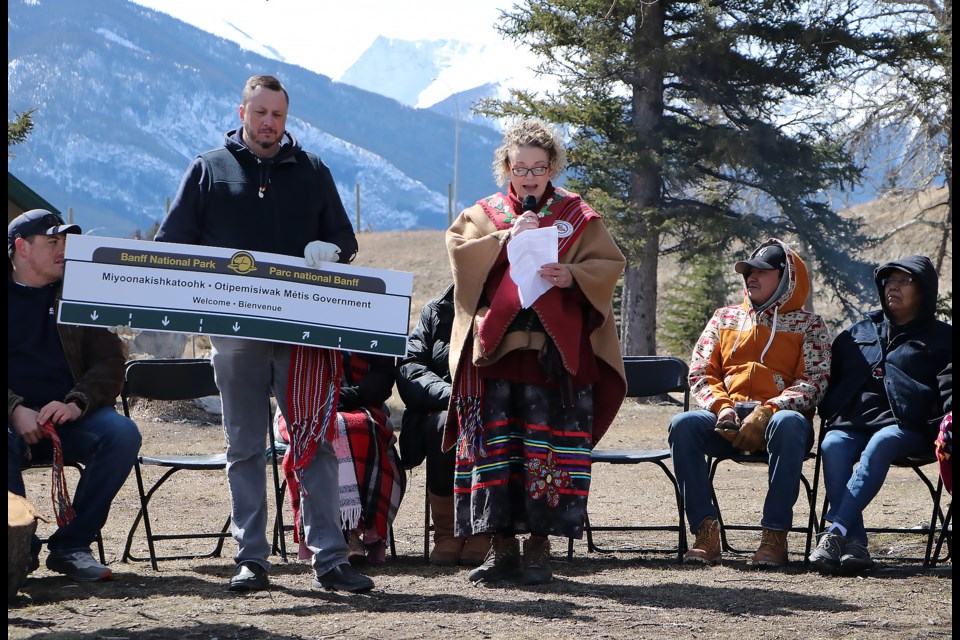BANFF NATIONAL PARK – Âba wathtech, oki, miyoonakishkatoohk, umba wathtāch, gwàdànisaàli nàdànásdàtłˈí, okâch.
These words and phrases representing Indigenous cultures now welcome visitors into Banff National Park, traditional territory of the Îyârhe (Stoney) Nakoda First Nation – Bearspaw, Chiniki and Goodstoney Nations; the Blackfoot Confederacy – Kainai, Siksika and Piikani Nations; the Métis Nation of Alberta and Tsuuti’na First Nation.
“It’s a big thing that our languages are going to be seen by the world here. To know who the first people are that have been here since time immemorial,” said Shay Runner, Tsuut’ina Nation councillor.
“It’s about time and a long time that visitors come and hopefully start talking about our tribes, start visiting us. We all have individual things that we can offer – our culture, our heritage, our museums.”
The phrase gwàdànisaàli nàdànásdàtłˈí in Tsuut’ina, which is part of the Dene language family, means ‘welcome, we are glad you are here.’
Including Indigenous verbiage on the Banff National Park east gate, the gantry sign stems from the collaborative efforts of the park’s Indigenous Advisory Circle, comprised of eight Indigenous groups.
The circle was formed in 2018 and is a hub of knowledge, offering insight and recommendations to park overseers on topics, issues and opportunities of importance.
A sign welcoming visitors to the area in Indigenous languages has been in the works for over a year. Representatives of the advisory circle and Parks Canada staff came together at the Cascade Ponds day use area on April 10 to celebrate the milestone achievement.
Piikani elder Herman Many Guns emphasized the foundational significance of language within culture and of Chief Sitting Behind an Eagle Tail, Piikani signatory of Treaty 7 in 1877 and Many Guns’ great-great grandfather.
“Today, I carry that name of Sitting Behind an Eagle Tail and I’m very honoured to carry that name because that ties us to the land and who we are, our culture, our customs and our way of life,” he said. “And also to acknowledge all the sacred people in our cultures – the ones who are bundle holders; the sacred societies that we have to maintain our language and to maintain our customs and beliefs that ties us to the land of we are as people.”
He said he was encouraged to see members of all Nations involved come together on the Banff gantry sign project, despite any historical differences.
“Today is a start, today is a change to all move forward together and recognize each other, put our differences aside … We all look at each other equally.”
The Îyârhe Nakoda First Nation, Blackfoot Confederacy and Tsuut’ina First Nation are all signatories of Treaty 7. The meaning of the English word ‘welcome’ is captured differently in the many Indigenous languages represented under treaty.
Oki, in Blackfoot, means ‘hello.’
Âba wathtech, a phrase used by Bearspaw First Nation, is a greeting meaning ‘good day.’ Umba wathtāch, a common phrase used by Chiniki and Goodstoney First Nations carries a similar meaning. The Stoney word ‘okâch,’ used by all three Nations, translates roughly to ‘there is open space; for someone to join.’
“I’d like to thank Parks Canada for this, which should have been done a long time ago,” said Chiniki Coun. Charles Mark. “I truly believe that and I’d like to thank everybody for coming today.”
In Michif, a distinct language of the Métis Nation of Alberta, miyoonakishkatoohk translates to ‘welcome.’
“So much of our district and ways in life are based in culture, especially Michif – our peoples’ language,” said Amber Boyd, district captain of the Otipemisiwak Métis Government of the Métis Nation of Alberta. “I want to thank our government partners at Parks Canada for working together to make this a reality. As Métis, we’ve been fighting for our very existence and recognition for over 200 years.
“To have our language officially recognized is a step in the right direction. From this day forward, anyone entering this majestic park will not only be treated to the sights and sounds of the wilderness, but also to be treated to a warm welcome in our traditional language.”
Superintendents for Banff and Lake Louise, Yoho and Kootenay national parks Sal Rasheed and François Masse were in attendance to mark the occasion and celebrate the Indigenous Advisory Circle’s achievement, along with Parks Canada CEO Ron Hallman and other parks staff.
“Today really is a historic day as evidenced by the number of Nations that have gathered together on this spot,” said Hallman. “It has been said that language is the cradle of culture and so we are deeply honoured that beginning today, and for the first time in the history of Banff National Park, visitors will be greeted in your languages and in your words – something that inspires Parks Canada and makes us deeply proud to be your partners.”
The Local Journalism Initiative is funded by the Government of Canada. The position covers Îyârhe (Stoney) Nakoda First Nation and Kananaskis Country.




